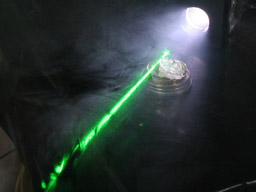
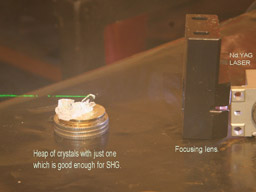
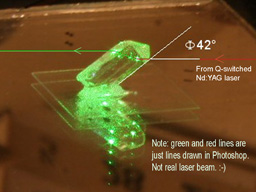
Long time ago I had idea to add a doubling crystal to my Nd:YAG laser to get green output. But the problem is that I have no idea which one to buy. There is many choices, but no simple guide which one will be appropriate for such Q-switched Nd:YAG laser. I have another Nd:YAG laser without Q-switch, and this complicates things a bit more if I want to get doubled frequency from that laser too.
I heard of KDP (chemical formula KH2PO4), and I have that chemical for hydroponic use, but did not believe that it is possible to grow decent crystal for SHG (Second Harmonic Generation). Since my school days, I know how to grow crystals with jar, chemical and just fiber. This type of growing crystals give only heap of crystals bond together, for which I not believe that it is possible to use as a SHG.
Just by accident, I watched video on YouTube about growing another type of crystal, so called ‘alum’, and there is explanation how to get single seeded crystal. Aside that, I saw another video where they grow KDP crystal for NIF (National Ignition Facility). Second video looks too complicated to me, so I decided to follow procedure for growing alum crystal, but with KH2PO4 chemical. Result was disappointing. I got many crystals aside from the seeded one, and mostly bonded together. I tried re-seed bigger one, but it lead to even worst situation.
After few attempts I gave up. What I get is hundreds of small crystals, for what I believed that there is no even smallest chance to get frequency doubling, or making other harmonics (THG, FHG, etc.). I tried to find information on the internet about whether someone got homegrown KDP crystal and use it as SHG. There is no results. Only result I got is about purchasing such crystals, but price is... huh... :-p
In private conversation with my friend Jarrod Kinsey he pushed me to try to put some small crystal at the output beam from the Nd:YAG laser anyway. I argued that this is not possible and that for such frequency doubling it is required special cut of the crystal, precision aligning, polarized laser, and so on.
Later on, I wanted to check what is necessary to get proper angle, but all I got is many offers for buying finished crystals with instructions how to use. At few pages they mentioned some angles, but also many other data, for what at this time I have no idea what they means. Until today I am not sure about many of that, but I am much more close to understanding it.
Laser is there, crystals are there, but also many questions too. Finally, I got courage to try it. During preparing for this test, I had all the time idea how to tell him that it failed, and that he is wrong. Also, I remember conversation with another friend, Jon Singer, a long time ago about this subject, before my attempt to grow crystals. He mentioned to me that this may be difficult too, but not impossible. He also mentioned that it is worth to try to grow crystals; “What’s to lose?”
With all of that on my mind, and with serious doubt, I wear safety goggles and fire my laser with focusing lens onto small KDP crystal. I had no idea where to point that focus. I tried few times with different angles, and WOW! Green light popped right out of the crystal. At first very weak, but at that moment, my excitement increased my perception of such intensity to the extreme. By slightly changing angle, I got even more green light out.
It took me a while until cool down my mind and realized
what I got. Then I reported to my friends on the
Lasers -- Laser and high-energy physics hacking
mailing list, who congratulated me for this achievement.
At third picture from the left, there is glued crystal
at approximately 42° to the incoming beam. Note that
I am not sure of the exact angle, because incoming beam
is focused, which produce cone of light. Such cone is
not so good, and part of the incoming energy is wasted.
I tried to use binocular as a beam shrinker. Instead of
3 mm beam, my attempt is to narrow it to about 0.3 mm
(if binocular has magnification 8x, then reversed should
narrow or shrink beam to very narrow beam. Such narrow
beam has high divergence, but at short distance it is
okay. After beam pass crystal, it will be good to use
beam expander to back to the original beam diameter, or
to expand beam even more to achieve lower divergence.
But I forgot that in binocular are glued two lenses
together to correct chromatic aberration. Here is how it
looks after a few laser pulses:
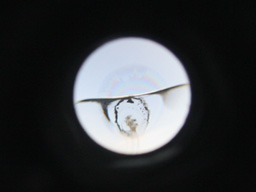
|
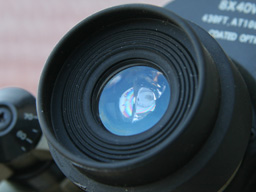
|
| View from the objective side. | View from the eyepiece side. |
There is glue, or optical cement between that two lenses.
It seems that some glues/cements don’t like IR (infra
red) radiation. I noticed that at first, there is only
burning spot, but as room temperature changes, one of
two lenses made different expansion rate and produce
crack.
I am mentioned birefringence which is visible on the green spot. By slightly adjusting (rotating) angle, that two groups of spots becomes one. When collimating to the infinite, such phenomena is less visible, because both spots make one small spot, slightly elliptic.
My both Nd:YAG lasers are non-polarized. For that reason I use so called ‘Type II’ phase matching. Since I am ‘newbie’ in that field, on the Internet you may find some nice article(s) about phase matching. One of them is:
http://ilphotonics.com/CD/Crystech-Crystals/Non_Linear_Crystals/nlo.pdfAnd another document:
http://www.quantumtech.com/apps/916.pdfCitation from page 5:
*4.
“When the cell is mounted horizontally in an optical mount, the screw (for filling the fluid) should face the ceiling. The polarization for the input beam should make and angle of 45° with respect to the horizontal or vertical plane. Slight Rotation and/or angular adjustment is required to obtain optimum efficiency.”
*5.
"Type II process is more efficient because the acceptance angle is wider, making alignment and thermal control less critical than Type I process, especially for doubling 1060nm. For tripling two orthogonally polarized beams, this process is attractive if the crystal is cut at the proper angle for tripling. The distance between the doubler and tripler should be as small as possible for best efficiency. Two orthogonally polarized beams should make an angle of 45° when the cell is oriented as in instruction *4." [End of citation]
I tried tripling Nd:YAG laser, but since my laser is not polarized, and because there is huge amount of white light from flashlamp, can’t be sure whether I got 355 nm (THG) in UV range. For tripling frequency, there must be actually two crystals. One after another, carefully oriented, aligned and so on. Too much complicated for me at this moment.
One of the beauty for such wide acceptance angle is for beginners like me. Even when holding KDP crystal in hand, one may be able to adjust close to the proper angle, so that there is at least some green light. Further adjusting is then easier, because it increase or decrease intensity of doubled frequency very gently. Not so sharp like Phase I matching. I tried that too, but it works bad for non-polarized lasers.
Another good thing is that even completely fogged crystal produce some green light. Not much, but crystal glow green anyway. There is almost no output beam (no visible spot), just diffuse green glowing. Even most clear crystal produce some fluorescence which is consequence of change in refraction indexes. I am not completely sure how and why, because in relatively short period read so much documents, and this matter is very complex.
Such fluorescence can bee seen in clear crystals, so that one may see the path of the laser beam.
In one document (can’t remember which one), they said that fine powder can produce SHG too, but with helps of PMT (Photo Multiplier Tube). This means that random oriented small crystals, many of them will be accidentally oriented close to the proper angle, so that they can make frequency doubling. At that way, they get very dim green light which can be seen only with aid of PMT.
About conversion efficiency. I have no instruments for
measuring efficiency, and suppose that in my case,
efficiency of conversion is low. In one of my post to
the lasers mailing list, I mentioned that it is possible
to put KDP crystal intracavity for lasers which has not
Q-switch. On that way, one may get greater efficiency by
counting on standing waves inside laser resonator, But
this is very problematic if laser is not polarized. My
friend Douglas Little tried it and got some green light
out too. But after few shots, one or both HR mirrors,
got optical damage. Standing wave become stronger and
stronger each time passes lasing media. Just one part is
‘extracted’ and converted into harmonic. It will be good
that conversion efficiency is high, so that both laser
mirrors are HR, but one of them with added high
reflectance for 532 nm. If both HR mirrors are for 1064
nm, then doubled frequency will exit at both end of the
Nd:YAG doubled laser.
About making seed crystals. You may use an old method of
growing crystals as a start for growing small KDP
crystals for seeds.
An old method with string may give you bad result, so
consider alternative method, which is also simple.
If you are lucky enough, and get big crystal, after cutting to proper size and angle for SHG or THG use, rest of the crystal may serve as seed crystal. Chose part which is clear. Shape it and put it as a seed. Or, if big crystal not met quality requirement, at least one part of such crystal may serve as a seed crystal. Mostly clear part is pyramidal part of the KDP crystal. Prismatic part may be with inclusions, bubbles, water pockets, and other defects.
I have no chance to get enough big crystal yet. For such growing of near perfect crystals, it require more or less sophisticated apparatus, ultra pure water, well prepared solution etc. I use ’industrial grade’ KH2PO4, which bought in hydroponic store. It is marked as MKP 0-52-34. The problem with that chemical is that there is small amount of impurities as metal ions of Fe, Ca, and others. Such metal ions, as well as other organic and inorganic impurities partially or completely blocking growing of the KDP crystals. In one paper, I found that additives helps to remove such ions. Small percent of EDTA (ethylenediaminetetraacetic acid), typically 0.01% is added to remove such unwanted metals. I have not such chemical. Also, they add about 5% KCl to get wide metastable region in order to achieve better stability of the supersaturated solution.
Here is the page with that document:
http://www.crystalresearch.com/crt/ab40/867_a.pdfSometimes this server is unavailable, so here is an alternative. Another good document you may find here:
http://nataliazaitseva.com/docs/KDP_Review.pdf
As you may see, growing KDP crystals is not so easy at
first look. Especially if you have not proper material
for building such crystalizer, filtering system and
temperature controller. I have not only limited budget,
but also live in a place where most construction materials
are unavailable.
Vinkovci, Croatia, Mar 22, 2009
Electronic ma!l: a@b.c.d where ‘a’ is equal to ‘powerlab’, ‘b’ is equal to ‘email’, ‘c’ is equal to ‘t-com’, and ‘d’ is equal to ‘hr’
Phone: +385 32 354045
Last modified: Mon Mar 23 08:01:55 CUT 2009